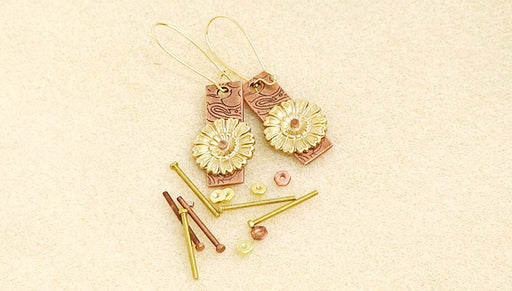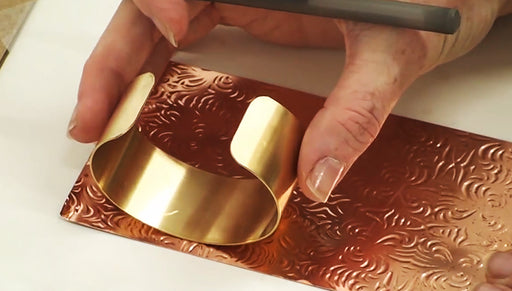
|
The Beadsmith Metalwork Hammer With Twelve Interchangeable Faces SKU: XTL-0003 $49.99 |

|
Rubber Bench Block 4 x 4 Inches - Base for Steel Block SKU: XTL-0254 $10.99 |

|
Solid Steel Bench Block - Wire Hardening and Wire Wrapping Tool SKU: XTL-6092 $15.99 |

|
Vintaj Metal Relief Block For Filing, Buffing & Sanding SKU: XTL-2222 $5.45 |
Hi, this is Julie with Beadaholique.com and today I wanna show you a great new tool. This is the BeadSmith metalworking hammer and what makes it so special is it actually has 12 interchangeable faces. I've got 2 faces on here already one on each side. I've got a waffle type pattern and some dots. It actually comes with four more decorative faces. I have got wide circles, smaller circles hash marks and stripes and I'll show you here in a moment how to go ahead and change out the faces and how to create some texture on a stamping blank as well. I have an example here some star earrings I did and I did those with the waffle texture. I'm going to that on a bigger star but in addition to the decorative plates you also have these great ones which are good for metalworking and shaping you're gonna get two nylon faces, one is domed and one is flat, two brass faces again one is domed, one is flat and two steel one domed, one flat. Now the difference between the flattened and the domed is the flat is gonna make it what it sounds like, it's going be flat it's gonna be like a pancake whereas the domed is gonna push the metal out just slightly. So flat would be good for working out some bends in a metal that you want it to be able to make the metal nice and straight again. The domed is gonna be good if you're going to curve metal around a mandrel or a bracelet blank. You're gonna wanna be able to work that metal hit one point of contact to curve it, move your hammer hit another point of contact and keep curving it. So pretty easy to remember domed is for curved, flat is for flats of course there's little bit of leeway in there as well but that's a good general rule of thumb now about the nylon, the brass and the steel the nylon is going to be for your softer metals. It's really good for plated if you hit a plated metal with the brass or the steel you run the risk of cracking the plating. It's also really good for thin wire, aluminum, smoothing out some surface imperfections, gentle shaping or if you do any hammering on filigree because filigree is so brittle you're gonna wanna make sure you use a really soft hammerhead like a nylon. Now brass is gonna be a middle ground it's going to be for dead soft to half hard wire and metals depending upon the gauge. So it's also really good for shaping as well and for getting out larger surface imperfections and then you're still think this as your hammer head for heavy lifting. It's gonna do the big jobs. You do run the risk of putting some marks into your metal, some work marks which you might have to then take out with the brass or the nylon later and that's why it's good that you have an interchangeable face hammer because if you do a pretty big job where you have shaped a bracelet with the steel, it has some marks you want to get out, you then go ahead and use the brass and the nylon to do so so think of it a bit like sandpaper if you're not familiar with that the heavier grit are gonna leave more streaks and then you'll do your finishing work with that softer tips. So what I wanna show you now is how to actually go ahead and use this hammer so you can see that the end caps are just screwed on and I'm just unscrewing and both sides have the same function and then for the actual face it just pops out. If you wanna place a different face in you just put it face-down and it catches there's a little bit of a lip on each of the faces and then you just screw it back into place just like so I wanna show you what this one, which is the smaller circles will result in. I've got a bench block with a rubber pad below it to help buffer some of the impact and I've got a Vintaj brass stamping blank here so I'm just going to take my hammer and I'm going to hammer and you can see what type of textures that provides. Now I wanna show you what the dots look like and there we have the dots and before I go any further and switching out these plates I want to take my Vintaj relief block which is my very well loved Vintaj relief block I'm going to relief to surface a little bit just so that the texture shows through a bit more you can really feel what looks like. So that was the circles and here are the dots so now I'm gonna go ahead and switch out my faces and show you the other four and you would put the nylon, the brass or the steel in the exact same way got the waffle pattern here and now you can just do a couple hits or you can do a lot. So this is what a couple hits like like just relief that really quickly got those great little squares now if you were to keep hammering it you'd end up with something that looked like that and I'll show you in the end of this video how to get that really intense texture going so it looks really kind of old and really worn. I wanna switch out I'll actually keep that face on their so I can show it to you later but I'll switch out the dots. The hammer has good weight to it but it's not overly heavy which is nice. If you ever forget which side goes on there is a lip here that you can actually feel so that's where you're going to go ahead and insert your face here are the hash marks that's what that texture looks like. So we did the wide circles so I'm going to do the thin I really like it when they overlap like that. Personally I like a lot of texture so usually in my designs you can see that I do a lot a hammering if I'm going to do it but it's totally up to you how you want to and we just got one more of these decorative plates to show you which is going to be the stripes and then I'm going to do the star. Always take proper safety precautions when you are working with metals and hammering make sure you keep your fingers out of the way If you're going to use any type of metal that might have parts fly off of it of course use safety goggles there we have the stripe texture so now I do want to show you how I did the stars so I've got a star stamping blank. Looks the same on both sides and I've got this great decorative head here that to me looks like a waffle pattern so I'm just going to start hammering and I'll keep hammering until the entire surface is covered one thing to keep in mind when using a hammer that has interchangeable faces like this is as you are hammering, double check periodically to make sure that the head has not become loose that all if it has go ahead and tighten it back up and then take my relief block and just sand the top of it just to expose some those raised areas exposed the shiny brass below. It'll really make the texture pop So there you go. You see without a lot of work and just by using the 12 face texture hammer I was able to create a really pretty design on a plain stamping blank. So that is the BeadSmith 12 face metalworking hammer. Very easy to use and gives you a lot of different possibilities for your designs. Go to www.beadaholique.com to purchase beading supplies and to get design ideas!
Related Videos


How to Use Nunn Design Micro Screw and Nut Sets
In this video, see how to use Nunn Design's new micro screw and nut sets to create a cold connection in jewelry making. These easy to use component...
View full details

How to Cover a Brass Cuff in Lillypilly Copper Sheets
Create a wonderful variety of cuff bracelets by using a brass cuff blank and covering it in Lillypilly Copper sheets. These sheets are available in...
View full details

How to Make Wire Jewelry Components for the Ambrosia Earring Set
In this video, see how to make several of the wire jewelry components used to make the Ambrosia Necklace and Earring set. These components are indi...
View full details